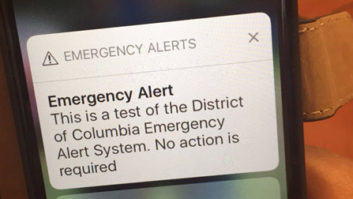The FCC is moving to make Wireless Emergency Alerts (WEA) available in more than a dozen languages.
In a Notice of Proposed Rulemaking (NPRM) adopted Friday, Apr. 21, the commission says it will require participating wireless providers in the United States to translate alerts into the 13 most commonly spoken languages aside from English. The notice also seeks comment on how WEA might support American Sign Language and text-to-speech.
It’s the latest move by the FCC to diversify delivery of emergency alerts — both WEA and EAS — to guarantee greater accessibility for non-English speaking populations and those with disabilities. The FCC has been searching for ways to ensure that people with weak proficiency in English are able to receive emergency alerts. WEA currently only supports alerts in English and Spanish.
FCC Chair Jessica Rosenworcel sent letters to the nation’s nine largest providers of WEAs earlier this year seeking information on how the alerts could support a more multilingual approach to emergency warning. Despite the commission’s recent efforts to bolster traditional EAS in this country, public warning experts say it appears the FCC believes WEA is more technology-ready to distribute alerts in a variety of languages.
Friday’s NPRM also enables alert originators to send thumbnail-sized images in WEA messages, which would be particularly helpful in AMBER Alerts, as well as links to location-aware maps, which would enable the public to see where they are in relation to an emergency situation.
The proposal also improves the flexibility of WEA by allowing alert originators to send WEA messages without the attention signal, which may be useful in situations where a sound could give away the location of a person in hiding or cause annoyance that spurs consumers to opt-out of WEA.
The FCC says it hopes to create a WEA database and require participating wireless providers to supply information on whether they offer WEA, where they offer WEA and which WEA-capable devices they sell. The move is part of an effort for the commission to establish minimum performance requirements for WEA reliability, accuracy and speed that participating wireless providers would have to meet.
The commission’s proposal would also include a WEA testing component which would “support WEA public awareness exercises by enabling alerting authorities to send two test alerts per year that the public receives by default.”
Since the WEA system became operational in 2012, the FCC says it has been used more than 70,000 times to distribute geographically-targeted, text-like messages to mobile devices warning the public about dangerous weather, missing children or other critical situations.
A comment period will commence 30 days after the date of publication of the NPRM in the Federal Register.











